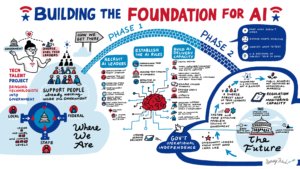Four Takeaways from Our “Building the Foundations for AI” Webinar

Just a few months ago, we held a webinar exploring philanthropy’s role in ensuring artificial intelligence (AI) tools are developed and deployed using a public interest technology lens. Then, in October, President Biden issued a landmark executive order (EO) that included new standards and best practices for government agencies to both leverage the potential and manage the risks of AI.
In the wake of the president’s directive, we convened another brilliant group of leading AI and public interest technology experts to reflect on the executive order and surface actionable insights for communities and systems, as well as opportunities for investment. This issue is one of the most transformational and urgent of our time, and we’re committed to continuing the conversation about how philanthropists can promote the responsible use of AI and bridge gaps between the private and public sectors to further this goal.
We were thrilled to join in conversation with Michelle Shevin of the Ford Foundation; Jennifer Anastasoff, the founder and executive director of Tech Talent Project; Travis Moore, the executive director of TechCongress; and Nishant Shah, senior advisor for Responsible AI for the state of Maryland. Shelley Whelpton, a senior managing director at Arabella, moderated the conversation. If you missed it, be sure to check out the recording here.
Crucially, the EO calls for a government-wide search for AI talent and rapid hiring of these professionals. It is paramount that the government’s AI-related regulations, programs, policies, and initiatives are designed and driven by experts who understand the technology and grasp the need to apply it in a way that benefits all of us while minimizing harm. This urgent, time-bound call for more AI talent in the federal government raises the question: where does philanthropy fit in, and how can philanthropists and other stakeholders across the sector best use their resources to promote responsible innovation and deployment of tech tools?
That’s the main question panelists grappled with during our conversation. We’re excited to share four key takeaways from the discussion:
1. There are critical gaps in technology talent and capacity across government, with implications for the responsible use of AI.
The call-to-action emerging from this EO is to build a talent pipeline of public interest technologists to join government agencies and shape how AI is used—both within government and the industries that government regulates. Officials need specific expertise to make informed policy decisions about AI that consider the relevant benefits and risks while placing community needs at the forefront. And it isn’t just top leaders—we need individuals at all levels and in every corner of government who are equipped with this knowledge, from young professionals to those overseeing large budgets across the executive and legislative branches.
The government also needs help knowing who and how to hire. Attracting and onboarding folks with expertise in rapidly evolving technology is new frontier for the government. Doing this effectively will enable the government to better deliver on its promises to the American public by ensuring it can harness the power of AI while protecting communities from the irresponsible deployment of it.
2. Nonprofits and philanthropists can play a pivotal role in overcoming barriers to entry for technology experts transitioning from private- to public-sector roles.
It’s important to acknowledge the root causes that impede government agencies from proactively building their technological capacity. Entering the public sector is fraught with bureaucratic hurdles that lengthen the hiring and onboarding process. The discrepancy in compensation between the private and public sectors can also be a disincentive. Finally, many individuals opt out of government roles because of the desire to stay at the cutting-edge of their fields by driving innovation in the private sector or in industry-specific roles.
Fortunately, there are a number of organizations working to address these gaps. The panelists highlighted the Tech Talent Project and Tech Congress—nonprofits that bring tech expertise to the public sector by identifying diverse pools of talent, acting as intermediaries to streamline the government hiring process, and providing necessary training to set up new hires for success.
Panelists shared that they’ve seen an increasing appetite among technologists to play a direct role in advancing the public good. Framing a career in the public sector as an opportunity to drive change for the betterment of society has been effective in building a pipeline of technology talent thus far.

The Tech Talent Project has developed a roadmap for hiring more technologists into government and building governmental capacity to effectively regulate AI. Click here to view the full image from ImageThink.
3. There are a number of ways philanthropists can activate their resources to advance AI for the public good.
There are several kinds of capital that funders can provide here. For one, philanthropists can play a critical intermediary role in supporting the movement of technology talent into the government. They can also mobilize their resources to drive the development of career development pathways in the public sector, ensuring folks are set up for growth and can continue to drive meaningful, well-informed policy decisions. Beyond technical knowledge, technology leaders must be equipped with tools to navigate bureaucracy in order to succeed within government structures—another area where philanthropy can direct resources.
Finally, the wide-ranging network and resources available to philanthropists means the sector is well positioned to share proof of the value proposition of these recruiting and retention efforts as a way to bolster collective support and action. When philanthropists, government, and nonprofits align on inclusive solutions, we can empower our elected officials to effectively serve the public interest
4. The time for philanthropists to invest is now—and the return on investment is clear.
Artificial intelligence isn’t new—it’s been unfolding for the past 50 years. However, the past year has brought a significant surge in activity surrounding AI and its potential to both revolutionize and pose risks to our society. Biden’s executive order further accelerated the appetite for cultivating public interest technology leaders who can manage these opportunities and challenges. In fact, Biden announced a 180-day deadline to accomplish a number of talent-related goals. With this increased momentum, the moment is ripe for philanthropy to engage.
To understand the far-reaching impact and return on investment that these efforts can have, the panelists urged us to situate this tide of rapid technological change in the context of society’s most vulnerable communities. Across health care, nutrition, immigration, and education, we must clearly understand how to use AI responsibly to improve the lives of historically overlooked populations—a key reason why getting technological experts into the government is so critical. Philanthropists are well positioned to drive change in support of these vulnerable communities by investing in efforts to build the tech talent pipeline with leaders who will drive responsible tech and AI innovation that benefits all.
As a sector, we can play an enormous role in bringing the right technology talent to the right places in the public sector—and it’s clearer than ever that now is the time to take action.
